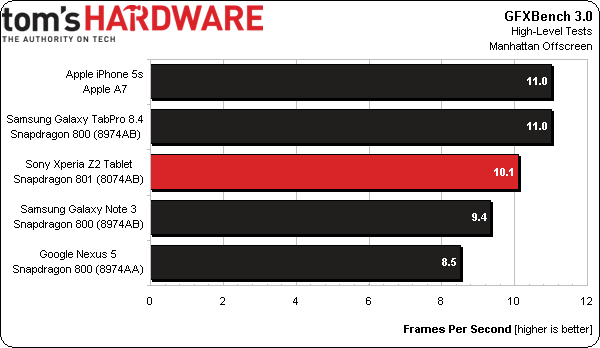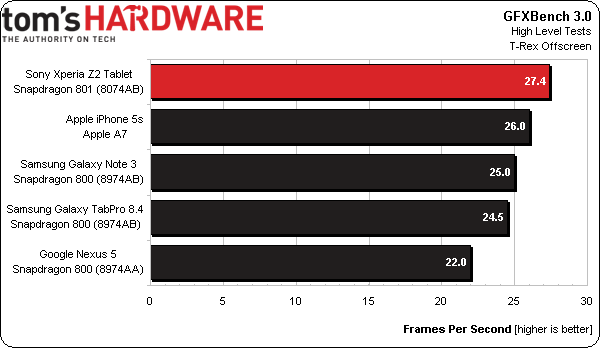Qualcomm Snapdragon 801: Performance Previewed
Snapdragon 801, the recently-announced update to the Snapdragon 800, shares some of the same SKUs as Snapdragon 800. So, how do you tell the difference? We break down the family and introduce you to the first benchmarks of Sony's Xperia Z2 tablet, too.
GFXBench 3.0: Manhattan And T-Rex
We reviewed Kishonti’s GFXBench 3.0 a few weeks ago, and we think it’s a good addition to our benchmark arsenal. We appreciate both the variety and detail of its individual tests, especially the fact that they’re broken up into high- and low-level groups. High-level tests simulate the nature of 3D applications, in particular, games. They do so by rendering scenes with an incredible amount of detail, utilizing the kind of GPU-stressing effects that a high-end game might put into effect.
The high-level tests include both an OpenGL ES 3.0-level test (Manhattan) and an OpenGL ES 2.0-level test (T-Rex). Manhattan renders a nighttime city scene where a giant robot takes on armored tanks, all while colored spot lights move about the scene. It uses a combination of forward and deferred rendering, and a whole lot of real-time lighting, making Manhattan the most modern and demanding GPU test in our suite. T-Rex simulates an action sequence where a motocross biker is chased through the jungle by a lumbering Tyrannosaurus. While not quite as a modern as Manhattan, T-Rex still strains the GPU by using several demanding effects simultaneously.
Manhattan 1080p Off-Screen
Normally, we’d run both the native resolution and off-screen tests in a product review, but today we’re more interested in comparing SoCs rather than devices, so native resolution isn’t relevant.
The iPhone 5s and Samsung Tab Pro 8.4 take first and second place with extremely close scores. The Xperia Z2 places third. Technically, it should be ahead, or at least equal to the Samsung Tab Pro 8.4, since it sports a faster GPU core.
Samsung’s Galaxy Note 3 slips into fourth place, which is also strange, since the Note 3 features the same 550 MHz Adreno 330 GPU and TouchWiz software overlay as the Tab Pro 8.4; it should at least be on par. Our guess would be that the smaller device is throttling due to heat. After all, Manhattan is an aggressive benchmark, and the Note 3 is in a more compact form factor.
T-Rex 1080p Off-Screen
T-Rex is a demanding OpenGL ES 2.0-based test that utilizes many modern effects, including materials, high-res textures, motion blur, parallax mapping, and complex particle systems. It also uses complex geometry, planar reflections, specular highlights, and soft shadows as part of the render pipeline.
Here more than in Manhattan, the Snapdragon 801’s speed-boosted Adreno 330 really begin to show its worth, the Xperia Z2 takes first place with a five-percent lead over the iPhone 5s, and of course, that lead could increase with access to the SoC's peak memory bandwidth. Handicapped subsystem aside, this is the first time that a Snapdragon processor has beaten Apple's A7 in this test. Both of the Snapdragon 800 -AB devices fall behind the A7-equipped iPhone 5s.
Get Tom's Hardware's best news and in-depth reviews, straight to your inbox.
Alright, so we’ve established that the Xperia Z2 tablet’s Snapdragon 801 is performing better than Snapdragon 800-based devices in GPU tests (despite pre-production idiosyncrasies). Now let’s see why.
Current page: GFXBench 3.0: Manhattan And T-Rex
Prev Page 3DMark And Basemark X 1.1 Next Page GFXBench 3.0: ALU, Alpha Blending, And Fillrate
